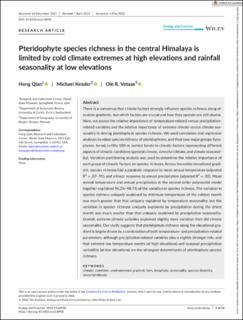| dc.description.abstract | There is a consensus that climate factors strongly influence species richness along elevation gradients, but which factors are crucial and how they operate are still elusive. Here, we assess the relative importance of temperature-related versus precipitation-related variables and the relative importance of extreme climate versus climate seasonality in driving pteridophyte species richness. We used correlation and regression analyses to relate species richness of pteridophytes, and their two major groups (lycophytes, ferns), in fifty 100-m vertical bands to climatic factors representing different aspects of climatic conditions (general climate, stressful climate, and climate seasonality). Variation partitioning analysis was used to determine the relative importance of each group of climatic factors on species richness. Across the entire elevational gradient, species richness had a parabolic response to mean annual temperature (adjusted R2 = .87−.91), and a linear response to annual precipitation (adjusted R2 = .82). Mean annual temperature and annual precipitation in the second-order polynomial model together explained 96.3%−98.7% of the variation in species richness. The variation in species richness uniquely explained by minimum temperature of the coldest month was much greater than that uniquely explained by temperature seasonality, but the variation in species richness uniquely explained by precipitation during the driest month was much smaller than that uniquely explained by precipitation seasonality. Overall, extreme climate variables explained slightly more variation than did climate seasonality. Our study suggests that pteridophyte richness along the elevational gradient is largely driven by a combination of both temperature- and precipitation-related parameters, although precipitation-related variables play a slightly stronger role, and that extreme low temperature events (at high elevations) and seasonal precipitation variability (at low elevations) are the strongest determinants of pteridophyte species richness. | en_US |

